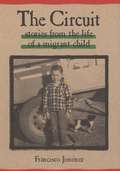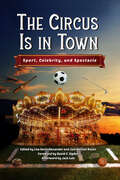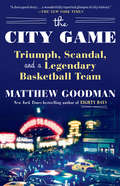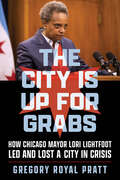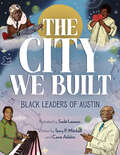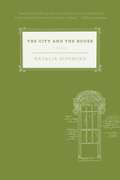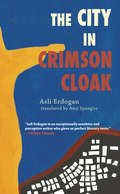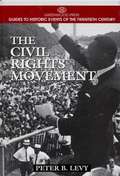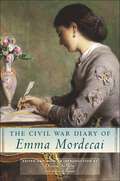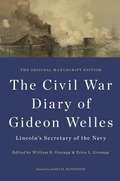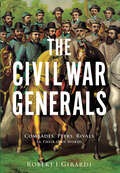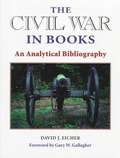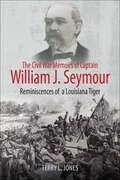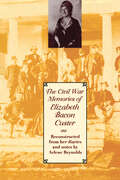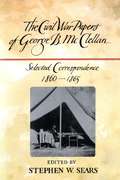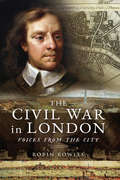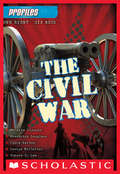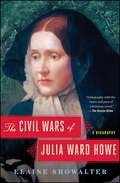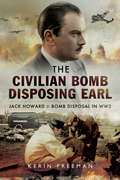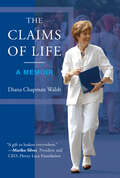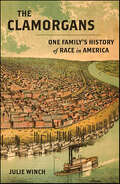- Table View
- List View
The Circuit
by Francisco Jiménez"'La frontera'...I heard it for the first time back in the late 1940s when Papa and Mama told me and Roberto, my older brother, that someday we would take a long trip north, cross la frontera, enter California, and leave our poverty behind." So begins this honest and powerful account of a family's journey to the fields of California -- to a life of constant moving, from strawberry fields to cotton fields, from tent cities to one-room shacks, from picking grapes to topping carrots and thinning lettuce. Seen through the eyes of a boy who longs for an education and the right to call one place home, this is a story of survival, faith, and hope. It is a journey that will open readers' hearts and minds.
The Circulation of European Knowledge: Niklas Luhmann in the Hispanic Americas
by Leandro Rodriguez MedinaThis book studies the circulation of social knowledge by focusing on the reception of Niklas Luhmann's systems theory in Hispanic America. It shows that theories need active involvement from scholars in the receiving field in order to travel.
The Circus Is in Town: Sport, Celebrity, and Spectacle
by Jack LuleContributions by Lisa Doris Alexander, Matthew H. Barton, Andrew C. Billings, Carlton Brick, Ted M. Butryn, Brian Carroll, Arthur T. Challis, Roxane Coche, Curtis M. Harris, Jay Johnson, Melvin Lewis, Jack Lule, Rory Magrath, Matthew A. Masucci, Andrew McIntosh, Jorge E. Moraga, Leigh M. Moscowitz, David C. Ogden, Joel Nathan Rosen, Kevin A. Stein, and Henry YuIn this fifth book on sport and the nature of reputation, editors Lisa Doris Alexander and Joel Nathan Rosen have tasked their contributors with examining reputation from the perspective of celebrity and spectacle, which in some cases can be better defined as scandal. The subjects chronicled in this volume have all proven themselves to exist somewhere on the spectacular spectrum—the spotlight seemed always to gravitate toward them. All have displayed phenomenal feats of athletic prowess and artistry, and all have faced a controversy or been thrust into a situation that grows from age-old notions of the spectacle. Some handled the hoopla like the champions they are, or were, while others struggled and even faded amid the hustle and flow of their runaway celebrity. While their individual narratives are engrossing, these stories collectively paint a portrait of sport and spectacle that offers context and clarity. Written by a range of scholarly contributors from multiple disciplines, The Circus Is in Town: Sport, Celebrity, and Spectacle contains careful analysis of such megastars as LeBron James, Tonya Harding, David Beckham, Shaquille O’Neal, Maria Sharapova, and Colin Kaepernick. This final volume of a project that has spanned the first three decades of the twenty-first century looks to sharpen questions regarding how it is that reputations of celebrity athletes are forged, maintained, transformed, repurposed, destroyed, and at times rehabilitated. The subjects in this collection have been driven by this notion of the spectacle in ways that offer interesting and entertaining inquiry into the arc of athletic reputations.
The City Game: Triumph, Scandal, and a Legendary Basketball Team
by Matthew GoodmanThe powerful story of a college basketball team who carried an era&’s brightest hopes—racial harmony, social mobility, and the triumph of the underdog—but whose success was soon followed by a shocking downfall &“A masterpiece of American storytelling.&”—Gilbert King, Pulitzer Prize–winning author of Devil in the GroveThe unlikeliest of champions, the 1949–50 City College Beavers were extraordinary by every measure. New York&’s City College was a tuition-free, merit-based college in Harlem known far more for its intellectual achievements and political radicalism than its athletic prowess. Only two years after Jackie Robinson broke the Major League Baseball color barrier—and at a time when the National Basketball Association was still segregated—every single member of the Beavers was either Jewish or African American. But during that remarkable season, under the guidance of the legendary former player Nat Holman, this unheralded group of city kids would stun the basketball world by becoming the only team in history to win the NIT and NCAA tournaments in the same year. This team, though, proved to be extraordinary in another way: During the following season, all of the team&’s starting five were arrested by New York City detectives, charged with conspiring with gamblers to shave points. Almost overnight these beloved heroes turned into fallen idols. The story centers on two teammates and close friends, Eddie Roman and Floyd Layne, one white, one black, each caught up in the scandal, each searching for a path to personal redemption. Though banned from the NBA, Layne continued to devote himself to basketball, teaching the game to young people in his Bronx neighborhood and, ultimately, with Roman&’s help, finding another kind of triumph—one that no one could have anticipated. Drawing on interviews with the surviving members of that championship team, Matthew Goodman has created an indelible portrait of an era of smoke-filled arenas and Borscht Belt hotels, when college basketball was far more popular than the professional game. It was a time when gangsters controlled illegal sports betting, the police were on their payroll, and everyone, it seemed, was getting rich—except for the young men who actually played the games. Tautly paced and rich with period detail, The City Game tells a story both dramatic and poignant: of political corruption, duplicity in big-time college sports, and the deeper meaning of athletic success.
The City Is Up for Grabs: How Chicago Mayor Lori Lightfoot Led and Lost a City in Crisis
by Gregory Royal Pratt"Gregory Pratt had a rare front-row seat to the passions, problems, peculiarities, hopes, disappointments, shenanigans, and pettiness in the drama and farce that was Lori Lightfoot's uneasy tenure on the fifth floor at City Hall. What he delivers on these pages takes us backstage to give us a powerful, incisive portrait of the woman, the details of her mayoralty, and the many players who shared the stage." —Rick Kogan, Chicago Tribune reporter and author of A Chicago Tavern Chicago is a world-class city, but it is also a city in crisis. Crime is up, schools have repeatedly shut down due to conflict between City Hall and the powerful teachers' union, and COVID-19 only deepened the entrenched poverty, institutional racism, and endless tug of war between the city's haves and have nots. For four years, the person at the center of this storm was Lori Lightfoot. A groundbreaking figure—the first Black, gay woman to be elected mayor of a major city and only the second female mayor of Chicago—she knew the city was at a critical turning point when she took office in 2019. But the once-in-a-lifetime challenges she ended up facing were beyond anything she or anyone else saw coming. Chicago Tribune reporter Gregory Royal Pratt offers the first comprehensive behind-the-scenes look at the tumultuous single term of Mayor Lightfoot and the chaos that roiled the city and City Hall as she fought to live up to her promises to change the city's culture of corruption and villainy, reform its long-troubled police department, and make Chicago the safest big city in America. Some of Chicago's problems can be explained by forces greater than the mayor: national polarization, long-standing cultural and racial tensions, our plague years. But some are the result of Lightfoot's poor leadership at City Hall, a story that hasn't been told in full—until now.
The City We Built: Black Leaders of Austin (Arcadia Children's Books)
by Terry MitchellIn the tradition of Little Legends and Good Night Stories for Rebel Girls comes The City We Built: Black Leaders of Austin , an illustrated children's book honoring the extraordinary African American men and women who played a critical role in shaping Black Austin's social, political, and cultural heritage. A collaboration between The Black Leaders Collective; The George Washington Carver Museum, Cultural and Genealogy Center; and renowned Texas visual artist Sadé Lawson, The City We Built will take readers on an empowering and inspiring journey through Black Austin's history, highlighting such local luminaries as:Ada Anderson, Charles Atkins, Berl Handcox, Johnny Holmes, Azie Taylor Morton, Velma Roberts, Dorothy Turner, Willie Wells, and more. Featuring full-page biographies and vibrantly illustrated, full-color portraits, The City We Built will not only educate young readers and inspire a new generation of Austin Black leaders--but celebrate the heroes who helped build this remarkable city.
The City and the House: A Novel
by Natalia Ginzburg Cynthia ZarinA sophisticated new package for Natalia Ginzburg's classic fiction This powerful novel is set against the background of Italy from 1939 to 1944, from the anxious months before the country entered the war, through the war years, to the Allied victory with its trailing wake of anxiety, disappointment, and grief.The city is Rome, the hub of Italian life and culture. The house is Le Margherite, a home where the sprawling cast of The City and the House is welcome. At the center of this lush epistolary novel is Lucrezia, mother of five and lover of many. Among her lovers-and perhaps the father of one of her children-is Giuseppe. After the sale of Le Margherite, the characters wander aimlessly as if in search of a lost paradise.What was once rooted, local, and specific has become general and common, a matter of strangers and of pointless arrivals and departures. And at the edge of the novel are people no longer able to form any sustained or sustaining relationships. Here, once again, Ginzburg pulls us through a thrilling and true exploration of the disintegration of family in modern society. She handles a host of characters with a deft touch and her typical impressionist hand, and offers a story full of humanity, passion, and keen perception.
The City in Crimson Cloak
by Asli ErdoganFrom an “exceptionally sensitive and perceptive” Turkish writer and human rights activist (Orhan Pamuk, winner of the Nobel Prize in Literature), the captivating story of a writer whose own autobiographical novel forces her to come to terms with the dichotomy of the city she once loved: Rio de Janeiro.Özgür is a young woman on fire: poor, hungry, and on the verge of a mental breakdown. She has only one weapon: her ability to write the city that has robbed her of everything, Rio de Janeiro. Through the reading of the bits and pieces of Özgür’s unfinished eponymous novel, with its autobiographical protagonist named Ö, Özgür’s story begins to emerge.As Özgür follows Ö through the shanty towns, Condomble rituals, and the violence and sexuality of the streets of Rio, the reader follows Özgür as she searches for a way to make peace with life, a route to catharsis. Together, the two concentric novels reveal the blurry borderline between the two Rio's -- one a metaphor for death, one a city of life. A major hit when it was released in Turkey and Europe, The City in Crimson Cloak is brilliantly evocative and wildly experimental, doing for Rio what Joyce did for Dublin.
The Civil Rights Movement
by Peter V. LevyA clear picture of the movement, including biographies of major figures and copies of significant portions of documents.
The Civil War Diary of Emma Mordecai (Goldstein-Goren Series in American Jewish History #25)
by Melissa R. Klapper Dianne AshtonA vivid look at the wartime experiences of a Jewish woman in the Confederate SouthEmma Mordecai lived an unusual life. She was Jewish when Jews comprised less than 1 percent of the population of the Old South, and unmarried in a culture that offered women few options other than marriage. She was American born when most American Jews were immigrants. She affirmed and maintained her dedication to Jewish religious practice and Jewish faith while many family members embraced Christianity. Yet she also lived well within the social parameters established for Southern white women, espoused Southern values, and owned enslaved African Americans.The Civil War Diary of Emma Mordecai is one of the few surviving Civil War diaries by a Jewish woman in the antebellum South. It charts her daily life and her evolving perspective on Confederate nationalism and Southern identity, Jewishness, women’s roles in wartime, gendered domestic roles in slave-owning households, and the centrality of family relationships. While never losing sight of the racist social and political structures that shaped Emma Mordecai’s world, the book chronicles her experiences with dislocation and the loss of her home.Bringing to life the hospital visits, food shortages, local sociability, Jewish observances, sounds and sights of nearby battles, and the very personal ramifications of emancipation and its aftermath for her household and family, The Civil War Diary of Emma Mordecai offers a valuable and distinct look at a unique historical figure from the waning years of the Civil War South.
The Civil War Diary of Gideon Welles, Lincoln's Secretary of the Navy: The Original Manuscript Edition
by Gideon Welles William E. Gienapp Erica L. GienappGideon Welles's 1861 appointment as secretary of the navy placed him at the hub of Union planning for the Civil War and in the midst of the powerful personalities vying for influence in Abraham Lincoln's cabinet. Although Welles initially knew little of naval matters, he rebuilt a service depleted by Confederate defections, planned actions that gave the Union badly needed victories in the war's early days, and oversaw a blockade that weakened the South's economy. Perhaps the hardest-working member of the cabinet, Welles still found time to keep a detailed diary that has become one of the key documents for understanding the inner workings of the Lincoln administration. In this new edition, William E. and Erica L. Gienapp have restored Welles's original observations, gleaned from the manuscript diaries at the Library of Congress and freed from his many later revisions, so that the reader can experience what he wrote in the moment. With his vitriolic pen, Welles captures the bitter disputes over strategy and war aims, lacerates colleagues from Secretary of State William H. Seward to General-in-Chief Henry Halleck, and condemns the actions of the self-serving southern elite he sees as responsible for the war. He can just as easily wax eloquent about the Navy's wartime achievements, extoll the virtues of Lincoln, or drop in a tidbit of Washington gossip. Carefully edited and extensively annotated, this edition contains a wealth of supplementary material. The several appendixes include short biographies of the members of Lincoln's cabinet, the retrospective Welles wrote after leaving office covering the period missing from the diary proper, and important letters regarding naval matters and international law.
The Civil War Generals: Comrades, Peers, Rivals: In Their Own Words (Civil War America Ser.)
by Robert I. Girardi“An excellent contribution to Civil War literature . . . . [A]n excellent reference resource. Civil War buffs in particular will greatly enjoy this book.” —ArmchairGeneral.comThe Civil War Generals offers an unvarnished and largely unknown window into what military generals wrote and said about each other during the Civil War era. Drawing on more than 170 sources—including the letters, diaries, and memoirs of the general officers of the Union and Confederate armies, as well as their staff officers and other prominent figures—Civil War historian Robert Girardi has compiled a valuable record of who these generals were and how they were perceived by their peers. The quotations within paint revealing pictures of the private subjects at hand and, just as often, the people writing about them—a fascinating look at the many diverse personalities of Civil War leadership. More than just a collection of quotations, The Civil War Generals is also a valuable research tool, moving beyond the best-known figures to provide contemporary character descriptions of more than four hundred Civil War generals. The quotes range in nature from praise to indictment, and differing opinions of each individual give a balanced view, making the book both entertaining and informative. A truly one-of-a-kind compilation illustrated with approximately one hundred historical photographs, The Civil War Generals will find a home not only with the casual reader and history buff, but also with the serious historian and researcher.
The Civil War In Books: An Analytical Bibliography
by David J. Eicher Gary W. GallagherThe guns had been silent for nearly half a century, the smoke and pain of battle long since dissipated. An aging veteran sat in a quiet room in his home in Philadelphia, reliving the events that shook the world, events that were now memories of a vanished age.
The Civil War Letters of Joseph Taylor
by Kevin C. MurphyLetters of a civil war Massachusetts soldier to his father
The Civil War Memoirs of Captain William J. Seymour: Reminiscences of a Louisiana Tiger
by Terry L. JonesA Confederate captain from the 1st Louisiana Brigade uses his skill as a newspaper editor to recount his experiences during the U.S. Civil War.Like many other soldiers who fought in the Civil War, New Orleans newspaper editor William J. Seymour left behind an account of his wartime experiences. It is the only memoir by any field or staff officer of the famous 1st Louisiana Brigade (Hays’ Brigade) in the Army of Northern Virginia. Long out of print, The Civil War Memoirs of Captain William J. Seymour: Reminiscences of a Louisiana Tiger is available once more in this updated and completely revised edition by award-winning author Terry L. Jones.Seymour’s invaluable narrative begins with his service as a volunteer aide to Confederate Gen. Johnson K. Duncan during the 1862 New Orleans campaign. Utilizing his journalistic background and eye for detail, Seymour recalls the siege of Fort Jackson (the only Southern soldier’s account except for official reports), the bickering and confusion among Confederate officers, and the subsequent mutiny and surrender of the fort’s defenders. Jailed after the fall of New Orleans for violating Maj. Gen. Ben Butler’s censorship order, Seymour was eventually released and joined General Hays’ staff in Virginia.Seymour’s memoirs cover his experiences in the army of Northern Virginia, including the campaigns of Chancellorsville, Gettysburg, Wilderness, and Shenandoah Valley, ending with the Battle of Cedar Creek in 1864. His pen recounts the activities of the Louisiana Brigade while offering a critical analysis of the tactics and strategies employed by the army.A perceptive and articulate officer, Seymour left behind an invaluable account of the Civil War’s drudgery and horror, pomp and glory. Terry L. Jones’ spare and judicious editing enhances Seymour’s memoirs to create an indispensable resource for Civil War historians and enthusiasts.
The Civil War Memories of Elizabeth Bacon Custer: Reconstructed From Her Diaries and Notes by Arlene Reynolds
by Elizabeth Bacon CusterIn her first year of marriage (1864–1865) to General George Armstrong Custer, Libbie Custer witnessed the Civil War firsthand. Her experiences of danger, hardship, and excitement made ideal material for a book, one that she worked on for years in later life but ultimately never published. In this volume, Arlene Reynolds has produced a readable narrative of Libbie Custer's life during the war years by chronologically reconstructing Libbie's original, unpublished notes and diaries found in the archives of the Little Big Horn Battlefield National Monument. In these reminiscences, Libbie Custer adds striking, eloquent details to the Civil War story as she describes her life both in camp and in Washington. Her stories of incidents such as fording a swollen river sidesaddle on horseback, dancing at the Inaugural Ball near President Lincoln, and watching the massive review of the Army of the Potomac after the surrender have the engrossing quality of a well-written novel. For general readers and students of women's history, this book tells a fascinating story of a sheltered girl's maturation into a courageous woman in the crucible of war. And for both devotees and detractors of her husband, it offers an intimate glimpse into his youth, West Point years, and early military service.
The Civil War Memories of Elizabeth Bacon Custer: Reconstructed From Her Diaries and Notes by Arlene Reynolds
by Elizabeth Bacon CusterThis collection of private writings by General Custer&’s wife offers an intimate look at their lives before and during the Civil War. In her first year of marriage (1864–1865) to General George Armstrong Custer, Libbie Custer witnessed the Civil War firsthand. Her experiences of danger, hardship, and excitement made ideal material for a book, one that she worked on later in life yet never published. In this volume, Arlene Reynolds presents a readable narrative of Libbie Custer's life during the war years by painstakingly reconstructing Libbie&’s original, unpublished notes and diaries found in the archives of the Little Big Horn Battlefield National Monument. In these reminiscences, Libbie Custer vividly describes her life both in camp and in Washington. She tells of incidents such as fording a swollen river sidesaddle on horseback, dancing at the Inaugural Ball near President Lincoln, and watching the massive review of the Army of the Potomac after the surrender. The resulting narrative tells the fascinating story of a sheltered girl's maturation into a courageous woman in the crucible of war. It also offers an intimate glimpse into the youth, West Point years, and early military service of General Custer.
The Civil War Papers of George B. McClellan: Selected Correspondence, 1860-1865 (Quality Paperbacks Ser.)
by Stephen W. SearsFrom the author of Gettysburg: A &“valuable&” collection of the letters of this controversial Civil War general (James M. McPherson, The New York Review of Books). No one played as many major roles during the Civil War as Gen. George B. McClellan, nor did any other figure write such candid letters about himself, his motivations, and his intentions. For Civil War buffs, this collection is a gold mine, revealing nuggets of fresh information on military operations and political machinations, from the battle of Antietam through McClellan&’s 1864 race for the presidency—as well as the uninhibited correspondence McClellan wrote to his wife—selected and introduced by the prize-winning author Stephen W. Sears, &“a first-class writer and splendid historian&” (The Wall Street Journal). &“A treasure-trove . . . Nothing of importance concerning [McClellan&’s] military strategies and tactics or the politics, policies, and issues of the war has been omitted. Sears has edited the collection with consummate economy and skill, and his introductory essays to the book&’s eleven sections weave the disparate facts of McClellan&’s wartime experience together.&” —Library Journal &“The letters are most valuable as a revelation of McClellan&’s personality, which lay at the root of his military failure. They make clear that his initial success and fame went to his head.&” —James M. McPherson, The New York Review of Books &“Introduced with insightful essays . . . [McClellan] emerges as the Captain Queeg of the Civil War.&” —Harold Holzer, Chicago Tribune
The Civil War in London: Voices from the City
by Robin RowlesThe Civil War years of the 1640s were amongst the most tumultuous in British history. The conflict between King Charles I and Parliament strained and split the social fabric of the British Isles. People of all classes who had previously coexisted peacefully found themselves opposing each other on political, religious, and economic grounds. Society was literally 'by the sword divided'.Much has been written on the subject to date. This book is different. London is its focus, with key players such as the Lord Mayor, the livery companies, the Church, and citizens, viewed through the city's lens and the streets around St Paul's and Cheapside. In looking at seemingly everyday events, unusual questions are raised: for example, where can you find a little known statue of Oliver Cromwell; what happened to the Cheapside Cross; who was Nemehiah Wallington and why was he important?The result of a London walk devised by the author, the books learned yet accessible approach will appeal to anyone interested in a new way of looking at a popular event in history. Bookended by the death of a Tudor queen and the beheading of a Stuart king, its chapters walk us through what happened in-between.
The Civil War: The Civil War (Profiles #1)
by Aaron RosenbergFind out how the key players from yesterday and today influenced and interacted with each other during the world's most important moments in this full-color biography series.One event. Six people. It takes more than one person to bring about change and innovation. So much more than just your typical biography, Profiles focuses on six of the most prominent figures during the Civil War. This book includes all of the biographical information kids need to know (background, family, education, accomplishments, etc.) about Abraham Lincoln, George McClellan, Matthew Brady, Clara Barton, Robert E. Lee, and Frederick Douglass. Find out why they were so important to the war and each other. Photographs, maps, and quotes are interwoven throughout the text.
The Civil Wars of Julia Ward Howe: A Biography
by Elaine ShowalterA &“lively biography&” (The New Yorker) of Julia Ward Howe, the powerful feminist pioneer and author of the Civil War anthem, &“Battle Hymn of the Republic.&”Julia Ward (1819–1910) was an heiress who married a handsome accomplished doctor who worked with the blind and deaf. But Samuel Howe wasted her inheritance, mistreated and belittled her, and tried to stifle her intellect and freedom. Nevertheless Julia persisted and wrote poetry and a mildly shocking sexual novel that was published to good reviews. She also wrote the words to probably the most famous anthem in the country&’s history—the Civil War anthem, &“Battle Hymn of the Republic.&” After Samuel died when she was fifty-one, Julia lived another forty years as a dynamic, tireless, and successful activist for women&’s rights, pacifism, and social reform. She became a groundbreaking figure in the abolitionist and suffrage movements, and a successful author and lecturer who fought her own battle for creative freedom and independence. In the &“riveting&” (The New York Times Book Review), &“unfailingly vivid&” (The Atlantic) and &“invigorating&” (O, The Oprah Magazine) The Civil Wars of Julia Ward Howe, esteemed author Elaine Showalter tells the story of Howe&’s determined self-creation and brings to life the society she inhabited and the obstacles she overcame. The Civil War challenged nineteenth-century ideas of separate spheres for men and women. In Howe&’s case, this transformation led to a rebellion against her marriage. She fought a second Civil War at home and discovered ways to combine domestic chores with creativity and politics, and she helped establish Mother&’s Day to honor women and to recruit them to her causes. &“A biography with the verve and pace of a delicious novel…Showalter reveals the entwining of Howe&’s public and private lives, as she righteously battled her husband and society, and finally saw the glory she always believed she deserved&” (The Boston Globe).
The Civilian Bomb Disposing Earl: Jack Howard and Bomb Disposal in WW2
by Kerin FreemanCharles 'Jack' Henry George Howard, GC, 20th Earl of Suffolk & Berkshire, born into the noble formidable House of Howard, possessed extraordinary courage. Jack became an earl at the age of eleven after his father died in WWI in Mesopotamia. At age thirty-four, Jack's courageous spirit led him to execute a daring mission for the British government in 1940 in Paris. Under the noses of the advancing Germans he snatched top French scientists, millions of pounds worth of diamonds, armaments, heavy water (the only kind in the world), and secret documents. His trip back to England from Bordeaux was fraught with danger in mine and submarine infested waters. His mission remained Top Secret throughout the war years and beyond, even to his closest family. His adventure in Paris earned him the nickname of 'Mad Jack'. His next chosen mission was again of prime importance and extremely dangerous, a secret more closely guarded than radar. He began working in bomb disposal in close proximity with his secretary Beryl, and Fred his chauffeur, and the three became widely known as The Holy Trinity. Whenever an unexploded bomb was reported, it was quickly brought to the Earl's attention, especially if it was tricky. Thirty four bombs were successfully defuzed by The Holy Trinity and their loyal team of Royal Engineers. The thirty-fifth bomb blew them up.The Holy Trinity were the only World War II civilian casualties working in Bomb Disposal. King George VI in 1941 awarded the 20th Earl the George Cross for his work for his country, the highest gallantry award for civilians, as well as for members of the armed forces, in actions for which purely military honours would not normally be granted.
The Claims of Life: A Memoir
by Diana Chapman WalshThe engaging memoir of a legendary president of Wellesley College known for authentic and open-hearted leadership, who drove innovation with power and love.The Claims of Life traces the emergence of a young woman who set out believing she wasn&’t particularly smart but went on to meet multiple tests of leadership in the American academy—a place where everyone wants to be heard and no one wants a boss. In college, Diana Chapman met Chris Walsh, who became a towering figure in academic science. Their marriage of fifty-seven years brought them to the forefront of revolutions in higher education, gender expectations, health-care delivery, and biomedical research.The Claims of Life offers readers an unusually intimate view of trustworthy leadership that begins and ends in self-knowledge. During a transformative fourteen-year Wellesley presidency, Walsh advanced women&’s authority, compassionate governance, and self-reinvention. After Wellesley, Walsh&’s interests took her to the boards of five national nonprofits galvanizing change. She kept counsel with Nobel laureates, feminist icons, and even the Dalai Lama, seeking solutions to the world&’s climate crisis.With an ear tuned to social issues, The Claims of Life is an inspiring account of a life lived with humor, insight, and meaning that will surely leave a lasting impression on its readers.
The Clam Lake Papers: A Winter in the North Woods
by Edward LuedersBook about the continuing alienation of humans from nature
The Clamorgans: One Family's History of Race in America
by Julie WinchThe Damning, Absurd, and Revelatory History of Race in America Told through the History of a Single FamilyHistorian Julie Winch uses her sweeping, multigenerational history of the unforgettable Clamorgans to chronicle how one family navigated race in America from the 1780s through the 1950s. What she discovers overturns decades of received academic wisdom. Far from an impermeable wall fixed by whites, race opened up a moral gray zone that enterprising blacks manipulated to whatever advantage they could obtain. The Clamorgan clan traces to the family patriarch Jacques Clamorgan, a French adventurer of questionable ethics who bought up, or at least claimed to have bought up, huge tracts of land around St. Louis. On his death, he bequeathed his holdings to his mixed-race, illegitimate heirs, setting off nearly two centuries of litigation. The result is a window on a remarkable family that by the early twentieth century variously claimed to be black, Creole, French, Spanish, Brazilian, Jewish, and white. The Clamorgans is a remarkable counterpoint to the central claim of whiteness studies, namely that race as a social construct was manipulated by whites to justify discrimination. Winch finds in the Clamorgans generations upon generations of men and women who studiously negotiated the very fluid notion of race to further their own interests. Winch's remarkable achievement is to capture in the vivid lives of this unforgettable family the degree to which race was open to manipulation by Americans on both sides of the racial divide.
